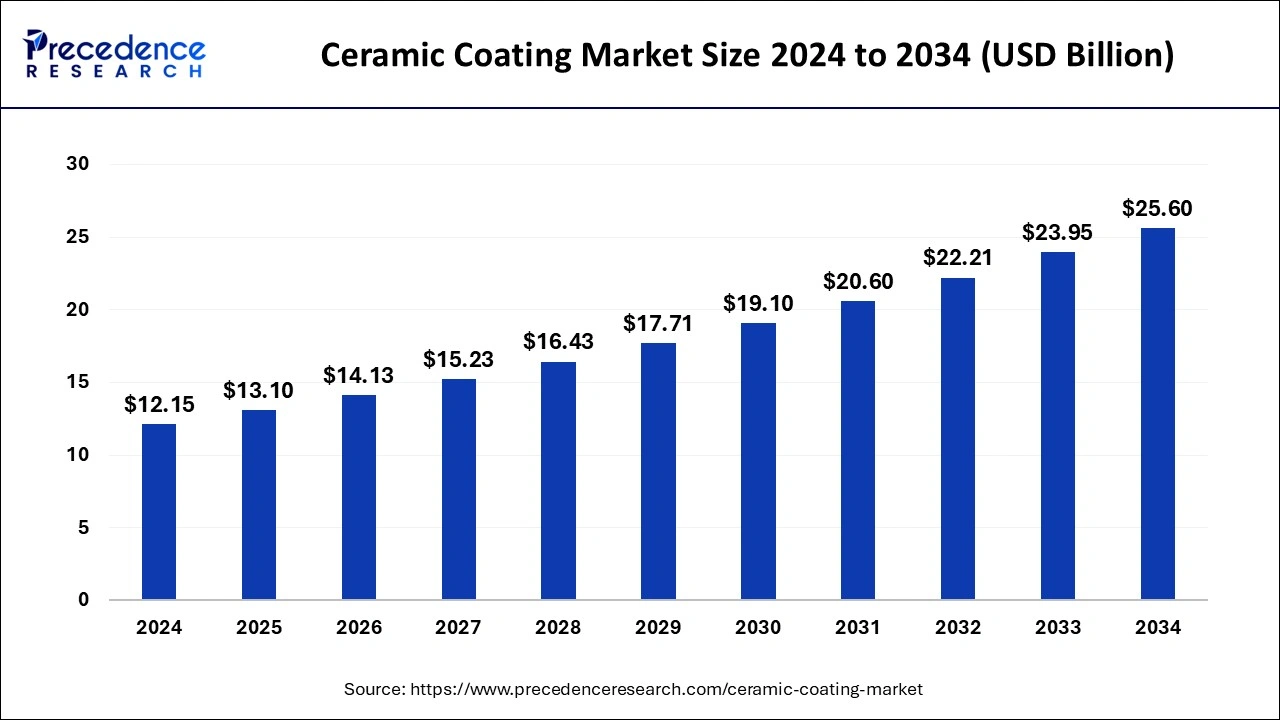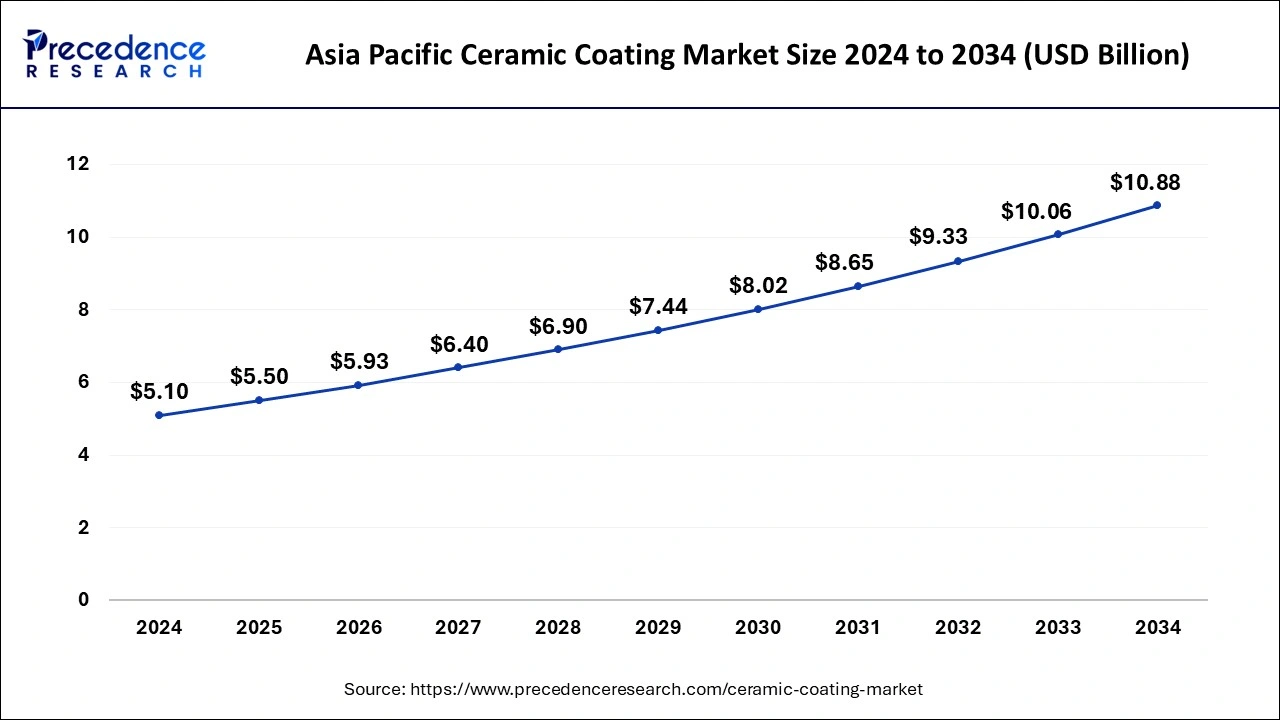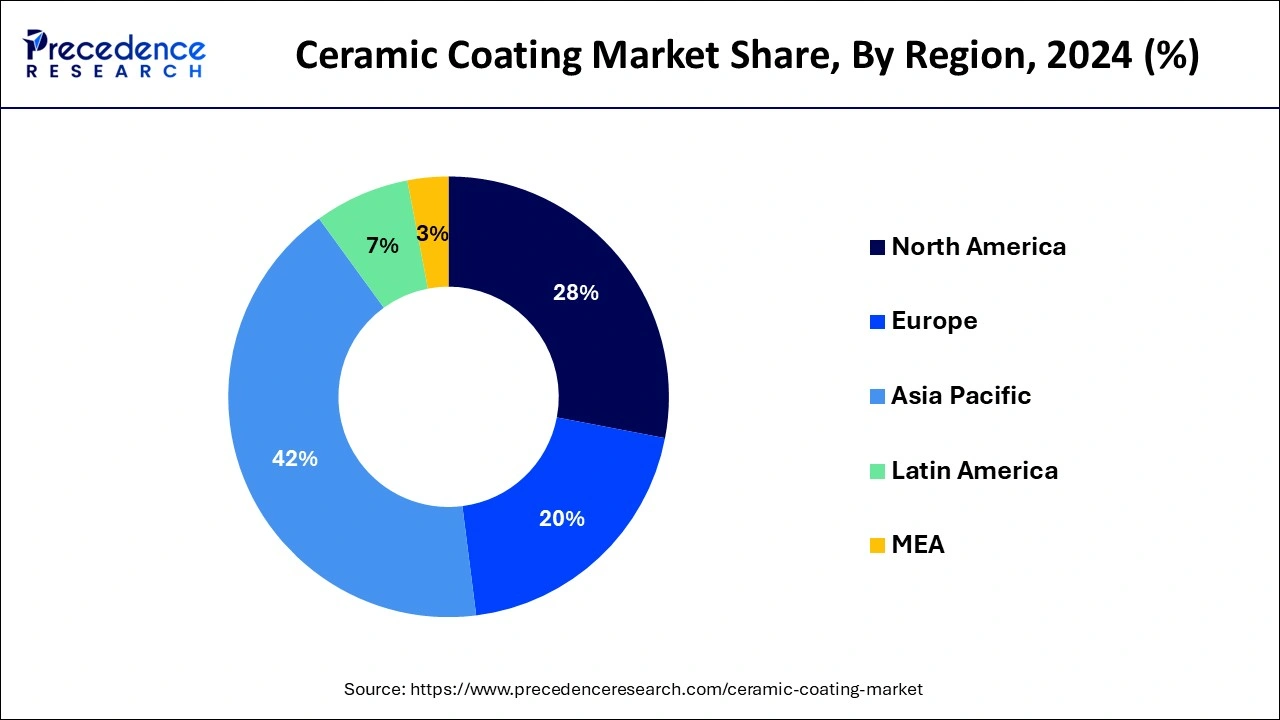January 2025
The global ceramic coating market size is calculated at USD 13.10 billion in 2025 and is forecasted to reach around USD 25.60 billion by 2034, accelerating at a CAGR of 7.74% from 2025 to 2034. The Asia Pacific ceramic coating market size surpassed USD 5.50 billion in 2025 and is expanding at a CAGR of 7.87% during the forecast period. The market sizing and forecasts are revenue-based (USD Million/Billion), with 2024 as the base year.
The global ceramic coating market size was estimated at USD 12.15 billion in 2024 and is predicted to increase from USD 13.10 billion in 2025 to approximately USD 25.60 billion by 2034, expanding at a CAGR of 7.74% from 2025 to 2034. The ceramic coating promotes increased heat resistance coupled with fewer emissions to the atmosphere. This factor is expected to drive the ceramic coating market growth during the forecast period.

The Asia Pacific ceramic coating market size was estimated at USD 5.10 billion in 2024 and is predicted to be worth around USD 10.88 billion by 2034 at a CAGR of 7.87% from 2025 to 2034.

Asia Pacific dominated the ceramic coating market in 2024. Low prices are often associated with lower-quality products rather than reduced operating costs. The significant demand in the region can be likened to consumption in developing countries like China, India, and Japan. The rise in engineering component manufacturing in the area is expected to boost regional demand in the forecasted period. China, a leading manufacturer of ceramic coatings, supplies most of the region's supply. Japan currently makes significant regional consumption and is projected to maintain its dominance throughout the forecast period.

North America is expected to grow at the fastest rate in the global ceramic coating market throughout the forecast period. This is largely due to rapid advancements in the automotive sector. Furthermore, ongoing developments in the aerospace industry are expected to contribute to market growth in the region during the assessment period. The presence of well-established automobile and aerospace industries has facilitated this level of ceramic coating consumption. Future market growth is anticipated to be driven by the automotive and healthcare product sectors.
High-temperature applications use ceramic coatings, which are composed of inorganic materials such as silicon carbide, silicon nitride, titania, hafnia, alumina, and alumina-magnesia. These coatings may find a wider market because of their increased heat resistance, long-term durability, and anti-erosion qualities. Using nanotechnology, a ceramic coating fills in gaps in car bodywork by creating a translucent layer that contains a liquid composite that binds at the molecular level with a paint solution. In comparison to other coatings, this produces a chemical bond with the paint that is imperceptible to the naked sight and produces less pollution.
Over the course of the forecast period, these factors are anticipated to propel the expansion of the ceramic coatings market. Additionally, because of their superior resistance to abrasive wear, corrosion, and heat insulation, ceramic coatings are being employed on metal components in autos on a growing basis. The aerospace and defense sectors are also seeing more applications of oxide and carbide coatings, which are used in space shuttles, insulating tiles, rocket exhaust cones, engine parts, and airplane windscreen panes.
| Report Coverage | Details |
| Growth Rate from 2025 to 2034 | CAGR of 7.74% |
| Market Size in 2025 | USD 13.10 Billion |
| Market Size by 2034 | USD 25.60 Billion |
| Largest Market | Asia Pacific |
| Base Year | 2024 |
| Forecast Period | 2025 to 2034 |
| Segments Covered | By Product, By Technology, and By Application |
| Regions Covered | North America, Europe, Asia-Pacific, Latin America, and Middle East & Africa |
Increasing demand for ceramic coatings in the aerospace & defense industry
Defense is dependent on a country's requirement for military assets for land, sea, and air operations, whereas the aviation sector is focused on the production, sale, and operation of commercial aircraft. The aerospace and defense industry is largely driven by the United States, but other nations have also recently played a significant role in its success, including China, France, India, Japan, the Middle East, Africa, and the United Kingdom. Turbine engines are frequently utilized for auxiliary power systems, aviation propulsion, and other applications. Ceramic layers called thermal barrier coatings are used to insulate heat engine parts. In gas turbine engines, these low-conductivity coatings can lower component temperatures by up to 1900°F by shielding air-cooled metallic parts from the hot gases produced by the engine.
Fragility and brittleness
Although ceramic coatings offer excellent thermal and chemical resistance, they are relatively brittle compared to other coatings. This brittleness makes them prone to cracking or chipping under mechanical stress or impact by limiting their use in industries that require high mechanical durability. Moreover, the global ceramic coating market has faced significant disruptions due to precautionary lockdowns and other restrictions imposed by governments worldwide. These disruptions have affected supply chains and industries, leading to decreased demand from major sectors like automotive and aerospace, unexpected plant closures, and temporary production halts. The market's year-over-year growth rate has slowed.
Antibacterial coating
Antibacterial coatings have recently become a trend. Vendor companies are keen to cover the latest trends, leading to the launch of antibacterial ceramic coatings that inhibit microorganism growth. These coatings are particularly used in the public transport sector, where surfaces are frequently touched by millions of people. Basic ceramic coatings are hydrophilic, serving as waterproof and non-stick clothing coatings, while non-stick coatings are used in furniture, electrical appliances, and glass. The demand for ceramic coatings is expected to rise due to their improved heat resistance and lower atmospheric emissions, driving the ceramic coating market expansion during the forecast period. Also, the sales of ceramic coating solutions are increasing as they protect metal car parts from abrasion and corrosion and provide an effective thermal barrier.
The oxide segment dominated the ceramic coating market in 2024. The oxide segment held the major market share and is likely to maintain its dominance during the forecast period. Compared to carbides and nitrides, oxides are more affordable. Oxide ceramic coatings protect metals against corrosion and serve as decorative and electrical insulators. These coatings can be applied to steel, cast iron, aluminum, copper, and zinc alloys. In this market, coating services help oil and gas exploration companies reduce exploration costs and increase production.
The ceramic coating market is expected to see rapid growth in the carbide segment. Carbide coatings are costly due to expensive raw materials and manufacturing processes. Carbon fiber coatings are also making their way into the sports industry with applications in horse hooves, golf clubs, and bicycles. XPEL, Inc. has expanded its FUSION PLUS automotive ceramic coating product line to include unique materials designed to protect trim surfaces, plastic, upholstery, glass, and brake calipers.
The thermal spray segment dominated the ceramic coating market in 2024. Thermal spraying is the most common technique for ceramic coatings, primarily made of metal oxides for wear resistance. Applying thermally sprayed ceramics to metal substrates enhances surface properties, providing thermal or electric insulation and resistance to wear and corrosion.
The PVD segment is the fastest-growing segment of the ceramic coating market. This growth is driven by the increasing demand for PVD coatings in the medical and electronics industries. PVD coatings enhance the performance of components by improving wear resistance, corrosion resistance, and biocompatibility. However, PVD coatings have limited resistance to high temperatures and surface pressures, making them unsuitable for heavy industries and aerospace applications.
The transportation & automotive segment held a significant share of the ceramic coating market due to its application on vehicle bodies. When applied, the ceramic coating chemically bonds with the factory paint, providing excellent surface protection. This coating shields vehicles from dirt, chemical contaminants, and scratches. Additionally, it makes the vehicle easier to clean and keeps its body panels smooth and free from abrasions.
It is anticipated that the energy segment would establish a significant foothold in the ceramic coating market based on application. Solar panels frequently employ ceramic coatings. They shield the glass from mineral deposits and sea spray, which can corrode and discolor it. The surface of solar panels is also endowed with hydrophobic and self-cleaning qualities by these coatings.
By Product
By Technology
By Application
By Geography
For inquiries regarding discounts, bulk purchases, or customization requests, please contact us at sales@precedenceresearch.com
No cookie-cutter, only authentic analysis – take the 1st step to become a Precedence Research client
January 2025
August 2024
February 2025
July 2024